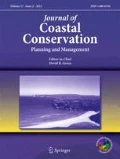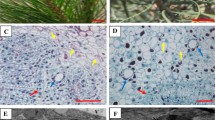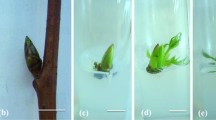Abstract
An efficient in vitro mass multiplication protocol was developed for selected species of screw pine (Pandanus fascicularis Lam., P. furcatus Roxb.). The protocol could be successfully used for large scale production of planting materials leading to cultivation and making bio-fences or green belts in coastal areas, wetlands for protection and preventing soil erosion. This will facilitate the replenishment of the bio resource and also provide good breeding space for various fauna associated with it. For developing the tissue culture protocol, shoot tips and tillers from the mature plants were used as the explants. Surface sterilization with 0.1 % mercuric chloride for 1 min. Yielded good fraction (65 %) of contamination free explants. Explants inoculated in MS solid medium supplemented with 6-benzylaminopurine (BAP, 2.5 mg/l) and indole-3-acetic acid (IAA, 0.5 mg/l), induced 2–3 shoot buds in 5 weeks. These buds either individually or along with the explant portion, sub-cultured to fresh media containing the same hormonal combinations, resulted induction of 5–6 shoot buds in 4 weeks. Repeated subcultures of shoot buds in the same medium produced 8–10 shoot buds in every 4 weeks. Shoot elongation was achieved (~ 3 cm) by transferring the shoot clusters or individual shoots to basal medium, and the elongated shoots were rooted in vitro or ex vitro. Root induction in shoots (87.4 %) was achieved in MS medium supplemented with 0.1 mg/l indole-3-butyric acid (IBA). Rooted shoots were established in paper/polythene cups filled with fine sand, which subsequently recorded 85 % establishment under the shade-net house with proper irrigation. Plants grown in poly-bags were later successfully established in different field conditions and recorded 100 % survival.





Similar content being viewed by others
References
Abral A, Fitra MG, Andriyanto H, Ilhamdi, Sapuan S M, Ishak M R, Evitayani (2012) Alkali Treatment of Screw Pine (Pandanus Odoratissimus) Fibers and Its effect on Unsaturated Polyester Composites. Polym-Plast Technol Eng 51:12–18
Akpabio UD, Akpakpan AE (2012) Pulp and paper from agricultural wastes: plantain pseudostem wastes and Screw pine leaves. Int J Mod Chem 2(3):100–107
Al-Bahrany AM, Al-Khayri JM (2003) Micropropagation of grey mangrove Avicennia marina. Plant Cell Tissue Organ Cult 72:87–93
Benson EE, Danaher JE, Pimbley IM, Anderson CT, Wake JE, Adams LK (2000) In vitro micropropagation of Primula scotica: a rare Scotish plant. Biodivers Conserv 9:711–726
Bird KT, Jewett-Smith J, Fonseca MS (1994) Use of in vitro – propagated Ruppia maritima for sea meadow restoration. J Coast Res 10:732–737
Danielsen F, Sorensen MK, Olwig MF, Selvam V, Parish F, Burgess ND, Hiraishi T, Karunagaran VM, Rasmussen MS, Hansen LB, Quarto A, Suryadiputra N (2005) The Asian tsunami: a protective role for coastal vegetation. Science 310:643
Gamborg OL, Miller RA, Ojima K (1968) Nutrient requirements of suspension cultures of soybean root cells. Exp Cell Res 50:151–158
Gangopadhyay G, Bandyopadhyay T, Modak BK, Wongpornchai S, Mukharjee KK (2004) Micropropagation of Indian pandan (Pandanus amaryllifolius Roxb), a rich source of 2-acetyl-1-pyrroline. Curr Sci 8711:1589–1592
Gopitha K, Bhavani AL, Manickam JS (2010) Effect of the different auxins and cytokinins in callus induction, shoot, root regeneration in sugarcane. Int J Pharm Bio Sci 1:1–7
Jafari N, Othman RY, Khalid N (2011) Effect of benzylaminopurine (BAP) pulsing onin Vitro shoot multiplication of Musa acuminata (banana) cv. Berangan. Afr J Biotechnol 13:2446–2450
Klavina D, Gailīte A, Ievinsh G (2006) Initial responses of explants from rare and endangered coastal plant species during initiation of tissue culture. Acta Univ Latv 710:81–91
Kurup SS, Aly MAM, Lekshmi G, Tawfik NH (2014) Rapid in vitro regeneration of date palm (Phoenix dactylifera L.) cv. Kheneizi using tender leaf explant. Emir J Food Agric 26:539–544
Li X, Gallagher JL (1996) Tissue culture and plant regeneration of big cordgrass, Spartina cynosuroides: implications for wetland restoration. Wetlands 16:410–415
Lokhande VH, Nikam TD, Ghane SG, Suprasanna P (2010) In vitro culture, plant regeneration and clonal behaviour of Sesuvium portulacastrum (L.) L.:a prospective halophyte. Physiol Mol Biol Plants 16(2):187–193
Lynett PJ, Borer J, Liu PLF, Synolasis CE (2003) Field survey and Numerical modeling of the 1998 Papua New Guinea tsunami. Pure Appl Geophys 160(3):2119–2146. doi:10.1007/s00024–003–2422-0
Mascarenhas A, Jayakumar S (2008) An environmental perspective of the post-tsunami scenario along the coast of Tamil Nadu, India: role of sand dunes and forests. J Environ Manag 89:24–34
McCown BH, Lloyd G (1981) Woody plant medium (WPM) – a mineral nutrient formulation for microculture of woody plant species. Hort Science 16:453–453
MSSRF Nineteenth Annual Report (2008–2009) M. S. Swaminathan Research Foundation, Chennai 600 113
Murashige T, Skoog F (1962) A revised medium for rapid growth and bio assays with tobacco tissue cultures. Physiol Plant 15:473–497
Nadaf AB, Zanan RL, Wakte KV (2011) A new endemic species of Pandanaceae from India: Pandanus palakkadensis. Kew Bull 66:183–186
Nayar TS, Rasia Beegum A, Mohanan N, Rajkumar G (2006) Flowering plants of Kerala- a Hand Book. TBGRI Publications, Thiruvananthapuram
NISCAIR, The Wealth of India (1966) A dictionary of Indian raw materials and industrial products, vol. VII (Council of Scientific Industrial Research, New Delhi, India), 216–221
Panda KK, Mohapatra S, Das LN, Mishra MK, Panda BB (2000) Optimal utilization of kewda Pandanus fascicularis to ameliorate economy and ecology of coastal India. J Med Arom Plant Sci 22(4a):679–682
Panda KK, Sahoo B, Das AB, Panda BB (2010) Use of RAPD markers to detect sex differences in Pandanus tectorius Parkinson, an important bioresource plant in Orissa, India. Int J Biodivers Sci Ecosyst Serv & Manag 6:1–2
Parkinson JV (2010) Flora of China, 23: 128–130
Paterson CN (2008) The ecological restoration of coastal terrestrial ecosystems in Southern Sri Lanka, Proceedings from International Conference on Building Education and Research (BEAR) 1368–1383
Peng LH, Cheng JL, Zhan RT, Li JR (2010) Research progress on the chemical constituents and biological activities of genus Pandanus. Chin Med Mater 33:640–643
Rasool R, Ganai BA, Kamili AN, Akbar S, Masood A (2013) Synergistic effect of auxins and cytokinins on propagation of Artemisia amygdalina (Asteraceae), a critically endangered plant of Kashmir. Pak J Bot 45:629–634
Ravindran PN, Balachandran I (2005) Underutilized Medicinal Species-III,” Spice India. 18:16–24
Sasidharan N (2004) Biodiversity documentation for Kerala. Part.6: Flowering Plants. Kerala Forest Research Institute, Peechi, Kerala. 1–2
Singh HP, Uma S, Selvarajan R, Karihaloo JL (2011) Micropropagation for production of quality banana planting material in Asia Pacific. Asia-Pacific Consortium on Agricultural Biotechnology (APCoAB), New Delhi, p 92
Stone BC (1974) Towards an improved infrageneric classification in Pandanus (Pandanaceae). Bot Jahrb Syst 94:459–540
Tanaka N (2009) Vegetation bioshields for tsunami mitigation: review of the effectiveness, limitations, construction, and sustainable management. Landsc Ecol Eng 5:71–79
Tanaka N, Sasaki Y (2007) Limitations of coastal vegetation in the 2004 Indian Ocean tsunami and 2006 Java tsunami, IAHR 32nd Congress, Venice
Tanaka N, Thuy N Ba (2010) Tsunami force mitigation by tropical coastal trees, Pandanus odoratissimus and Casuarina equisetifolia, considering the effect of tree breaking International Conference on Sustainable Built Environment (ICSBE-2010) Kandy, 13–14 December 2010
Tanaka N, Nandasena NAK, Jinadasa KBSN, Sasaki Y, Tanimoto K, Mowjood MIM (2009) Developing effective vegetation bioshield for tsunami protection. J Civ Environ Eng Syst 26:163–180
Thomson LAJ, Englberger L, Guarino L, Thaman RR, Elevitch CR (2006) Pandanus tectorius (Pandanus), Ver.1.1: In: Elevitch CR (ed) Species profile for Pacific Island agroforestry, Permanent agricultural resources (PAR), Hawai
Thuy NB, Tanaka N, Tanimoto K (2012) Tsunami mitigation by coastal vegetation considering the effect of tree breaking. J Coast Conserv 16:111–121
Tsuji Y, Imamura F, Matsutomi H, Synolakis CE, Nanang PT, Jumadi HS, Han SS, Arai K, Cook B (2003) Field survey of the east java earthquake and tsunami. PAGEOPH 144(3/4):839–854
Vinod MS, Raghavan PS, George S, Parida A (2007) Identification of a sex-specific SCAR marker in dioecious Pandanus fascicularis L. (Pandanaceae. Genome 50:834–839
Wakte KV, Nadaf AB, Thengane RJ, Jawali N (2009) In vitro regenerating plantlets in Pandanus amaryllifolius Roxb. As a model system to study the development of lower epidermal papillae. In Vitro Cell Dev Biol Plant 45:701–707
Watt MP, Thokoane NL, Mycock D, Blakeway F (2000) In vitro storage of Eucalyptus grandis germplasm under minimal growth conditions. Plant Cell Tissue Organ Cult 61:161–164
Xu J, Wang Y, Zhang Y, Chai T (2008) Rapid in vitro multiplication and ex vitro rooting of Malus zumi (Matsumura) Rehd. Acta Physiol Plant 30:129–132
Zarranz ME, Gonza’lez-Henrı’quez N, Garcı’a-Jime’nez P, Robaina RR (2010) Restoration of Cymodocea nodosa seagrass meadows through seed propagation: germination in vitro, seedling culture and field transplants. Bot Mar 53:173–181
Acknowledgments
The authors acknowledge Kerala State Industrial Development Corporation (KSIDC), Government of Kerala for financial support, Jawaharlal Nehru Tropical Botanic Garden & Research Institute (JNTBGRI), Thiruvananthapuram for providing the facilities and Kerala Forest Department for permitting us to collect Pandanus specimens from protected forest areas.
Author information
Authors and Affiliations
Corresponding author
Rights and permissions
About this article
Cite this article
Jose, B., Harikumar, K., Krishnan, P.N. et al. In vitro mass multiplication of screw pines (Pandanus spp.) - an important costal bio- resource. J Coast Conserv 20, 443–453 (2016). https://doi.org/10.1007/s11852-016-0458-4
Received:
Revised:
Accepted:
Published:
Issue Date:
DOI: https://doi.org/10.1007/s11852-016-0458-4




